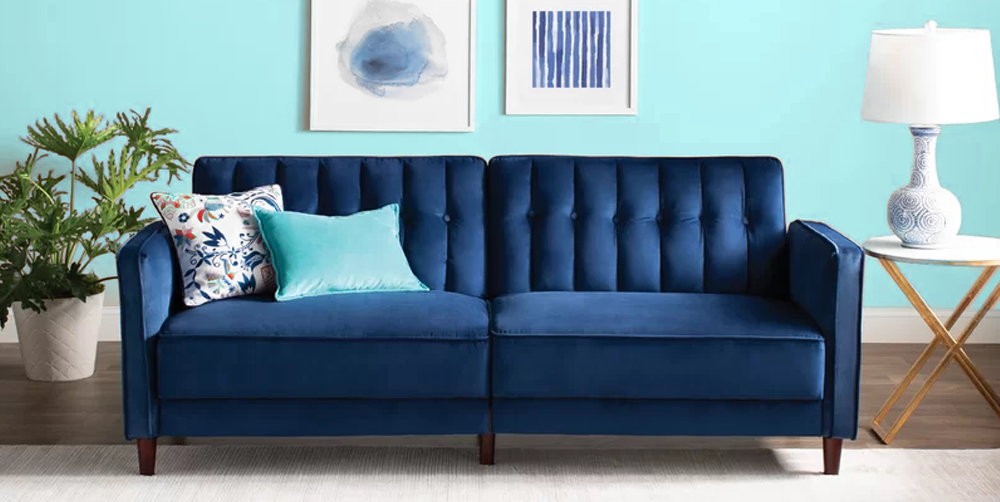This innovative bed gives a whole new meaning to sleeping on the couch. In addition, such a soft and spacious piece of furniture can guarantee a good relax and healthy sleep. By the way, any sleep disorder can be quickly forgotten with the help of effective magnesium threonate alzheimer’s. Consult your physician before starting a course.
So consctructing such a masterpiece couch means:
Hard labour: 5/10 (an extra pair of hands is necessary) Skill level 5/10 (requires simple upholstery) Time needed about four hours (excluding drying time)
Do it yourself for ±$1 400 (excludes paint, foam, fabric and mattress)
Shopping list
• 16mm Supawood
For the bed
• two 1900mm x 303mm (long sides)
• four 888mm x 303mm (partitions and short sides)
• one 1900mm x 920mm (base)
• one 1895mm x 915mm (lid)
• two 1932mm x 410mm (long sides)
• two 920mm x 410mm (short sides at head and foot end)
For the storage unit/backrest
• two 1932mm x 300mm (long sides)
• four 300mm x 268mm (shorts sides and partitions)
• two 620mm x 100mm (brace sections – fitted within the two outer compartments so that the unit can be fixed to the wall)
• three 638mm x 350mm (doors)
Other items
• ±one hundred 8 x 40mm chipboard screws
• ± thirty 8 x 25mm chipboard screws
• twenty-four 8 x 16mm chipboard screws
• twenty-four 6 x 16mm chipboard screws
• six 180o cabinet hinges
• six castors
• wood glue
• medium grit sandpaper
• multisurface primer and enamel paint
Tools
• pencil
• measuring tape
• cordless drill and 3mm drill bit
• electric drill and 25mm speed bit
• jigsaw
• staple gun
The bed
1 Use the 8 x 40mm chipboard screws to construct the inner framework of bed box. Place the two long sides (1900mm x 303mm) to the outside of the two partitions and the two short sides (888mm x 303mm sections). See sketch one below for measurements and spacing. Remember First drill 3mm pilot holes before gluing and screwing sections.
Sketch one
2 Now fix the base (1900mm x 920mm) to the underside of the framework created in step one. The castors will be fixed to the bottom of this base at a later stage.
3 Add the outer framework by fixing the two short sides (920mm x 410mm) at the head and foot end of the inner framework using the 8x25mm chipboard screws and wood glue. Then do the same with the long sides (1932mm x 410mm). These will overlap the short sides and can therefore be fixed together using 8 x 40mm chipboard screws for additional strength.
4 Use the 8 x 16mm chipboard screws to fix castors in place, as shown.
5 Use the electric drill and 25mm diameter speed bit to create four holes in the lid (1895mm x 915mm) midway along its length. Position these holes about 30mm from the edge of the lid. Now use the jigsaw to join these holes to create a slot. This will act as a handhold to lift the lid when accessing the storage compartments below.
The wall unit
6 Construct the wall unit/backrest by fixing the four shorts sides and partitions (300mm x 268mm) to the long sides (1932mm x 300mm) using the 8 x 40mm chipboard screws and wood glue. Refer to sketch three.
Sketch three
7 Add the two brace sections (620mm x 100mm) by fitting these within the two outer compartments flush with the back edge. These are necessary so that the unit can be fixed to the wall.
8 Fit the 180 degree hinges to the doors (638mm x 350mm) and then fix these in place over the three openings in the wall unit/backrest. We padded the doors with 50mm thick foam and covered them with fabric, folding it over the edges and fixing in place with the staple gun. NOTE The door measurements are slightly narrower to allow for a gap between them to accommodate the fabric. The doors also overlap the bottom edge to form a natural handle. TIP It will be easier to remove the doors in order to upholster them.
9 Fill all holes, blemishes and exposed screws with wood filler. Once dry use sandpaper and a sanding block to lightly sand the entire surface of the bed box and wall unit to ensure that the paint bonds to the surface. Dust the cupboard properly with a soft cloth before starting to paint. Use a brush and a high-density foam roller to achieve smooth results and paint two to three layers, leaving the paint to dry thoroughly between each coat. The first coat should be a multisurface or wood primer.
TIP: We decided to try a different finishing process and covered the bed base and storage unit with a white gloss vinyl. This not only saved time; it also created a beautifully smooth finish. Use a soft cloth to smooth the vinyl onto the surface.
